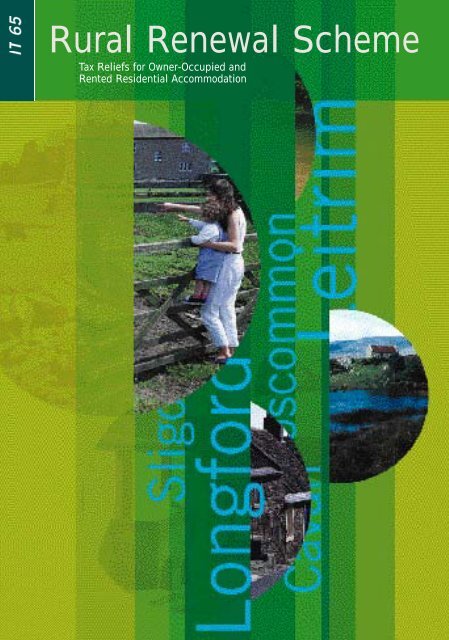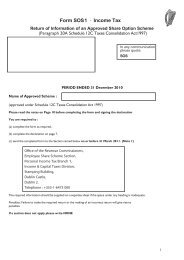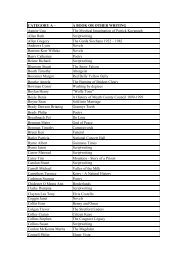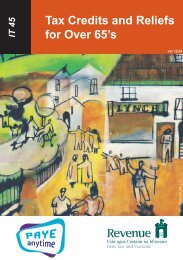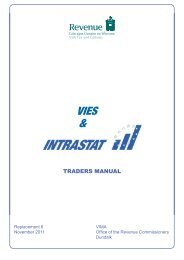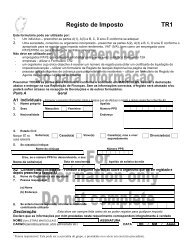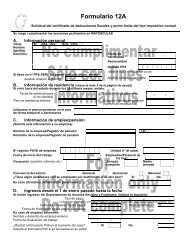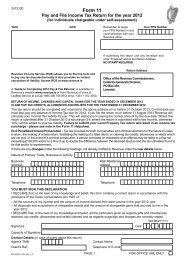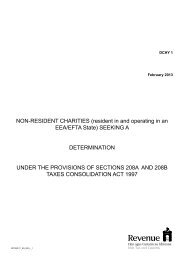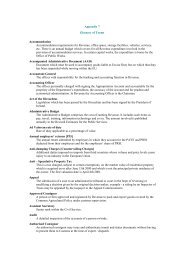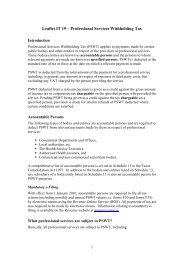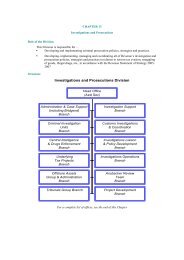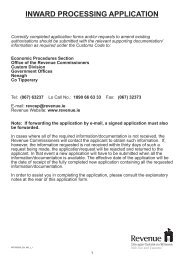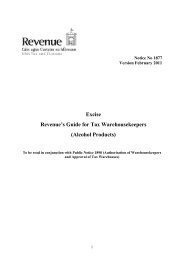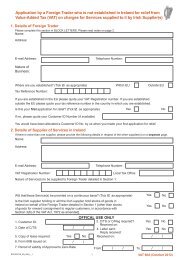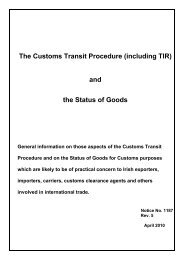Leaflet IT65 - Rural Renewal Scheme - Revenue Commissioners
Leaflet IT65 - Rural Renewal Scheme - Revenue Commissioners
Leaflet IT65 - Rural Renewal Scheme - Revenue Commissioners
Create successful ePaper yourself
Turn your PDF publications into a flip-book with our unique Google optimized e-Paper software.
<strong>Rural</strong> <strong>Renewal</strong> <strong>Scheme</strong><br />
Tax Reliefs for Owner-Occupied and<br />
Rented Residential Accommodation
<strong>Rural</strong> <strong>Renewal</strong> <strong>Scheme</strong> page 1<br />
Contents<br />
Foreword by the Minister for Finance 3<br />
Introduction 4<br />
Enquiries 4<br />
Outline of the scheme 5<br />
Meaning of terms 5<br />
Part 1 Owner-Occupied Accommodation<br />
The relief 8<br />
Qualifying house 9<br />
How relief is granted 9<br />
How to claim the relief 10<br />
Owner-occupation and sharing arrangements 12<br />
Part 2 Rented Residential Accommodation<br />
The relief 14<br />
Qualifying house 14<br />
How relief is granted 15<br />
How to claim the relief 16<br />
Withdrawal of relief 18<br />
Part 3 Amount of Qualifying Expenditure<br />
Introduction 20<br />
Newly Constructed House 21<br />
• Individual incurs expenditure on construction 21<br />
• New house purchased from a builder 21<br />
• New house purchased from a person who is not a builder 22<br />
Newly Refurbished/Converted House 23<br />
• Individual incurs expenditure on refurbishment/conversion 23<br />
• Newly refurbished/converted house purchased from a builder 24<br />
• Newly refurbished/converted house purchased from a person who 25<br />
is not a builder
page 22 <strong>Rural</strong> <strong>Renewal</strong> <strong>Scheme</strong><br />
Subsequent Sale of Rented Residential Accommodation 26<br />
• New house, which has been let, sold during 10 year period 26<br />
• Refurbished/converted house, which has been let, 27<br />
sold during 10 year period<br />
• House, which has been let, sold after 10 year period 27<br />
Appendices<br />
Appendix 1 Description of Qualifying <strong>Rural</strong> Areas 30<br />
Appendix 2 Guidelines for applying for Certificate of Compliance 34<br />
and Certificate of Reasonable Cost<br />
Appendix 3 HA2R - Technical Standards for Refurbishment and 38<br />
Conversion Works<br />
Appendix 4 Floor Area Calculations 40<br />
Appendix 5 Specimen Draft of Builder’s Statement 42<br />
Forms enclosed at the back of the booklet<br />
RRS 1<br />
RRS 2<br />
HPF/1<br />
HPF/2<br />
Claim form for Owner-Occupied Accommodation Relief<br />
Claim form for Rented Residential Accommodation Relief<br />
Application for a Certificate of Reasonable Cost<br />
Application for a Certificate of Compliance
<strong>Rural</strong> <strong>Renewal</strong> <strong>Scheme</strong> page 3<br />
Foreword by the Minister for Finance<br />
I am very pleased to introduce this guide to the <strong>Rural</strong> <strong>Renewal</strong><br />
<strong>Scheme</strong> which has been prepared by the <strong>Revenue</strong><br />
<strong>Commissioners</strong>. While as Minister for Finance, I have to be<br />
conscious of the needs of all the regions in the State, I<br />
decided to bring in special tax incentives in the 1998 and<br />
1999 Finance Acts targeted at the area covered by the pilot<br />
<strong>Rural</strong> <strong>Renewal</strong> <strong>Scheme</strong>. I think it would be generally accepted<br />
that this area has suffered particularly badly in the past<br />
decades in regard to social and economic conditions.<br />
I hope therefore that the residential tax incentives which are<br />
described in this booklet and the business tax incentives which<br />
I announced on 23 June last will help to improve the economic<br />
and social situation in the area over the period of this pilot<br />
<strong>Rural</strong> <strong>Renewal</strong> <strong>Scheme</strong> which is to last to 31 December 2002.<br />
Charlie McCreevy TD<br />
Minister for Finance<br />
August 1999
page 44 <strong>Rural</strong> <strong>Renewal</strong> <strong>Scheme</strong><br />
Introduction<br />
The <strong>Rural</strong> <strong>Renewal</strong> <strong>Scheme</strong>, which is aimed at regenerating parts of the Upper<br />
Shannon region, was first introduced in 1998. The scheme provides tax incentives<br />
for commercial and residential developments.<br />
The commercial part of the scheme is in operation from 1 July 1999 to<br />
31 December 2002.<br />
The residential part of the scheme originally applied only to properties which were<br />
let. The Finance Act 1999 extended the scheme to owner-occupied houses which<br />
comply with certain specifications.<br />
This booklet gives information on the residential part of the scheme. It is intended<br />
primarily for individuals who want to claim the relief. However, it is sufficiently<br />
detailed to be of use to property developers and to professionals who are advising<br />
prospective owner-occupiers or investors. Parts 1 and 2 of the booklet deal with<br />
the basics of the scheme. Part 3 deals with the calculation of the amount of the<br />
expenditure that qualifies for relief in different circumstances. Further details are<br />
included in the Appendices and application forms are enclosed at the back of the<br />
booklet.<br />
Enquiries<br />
Enquiries regarding taxation matters can be made to your local tax office (whose<br />
address and telephone number will be on any communication you received from<br />
that office) or by telephoning the Central Telephone Information Office at<br />
(01) 8780000.<br />
Copies of this booklet are available from the <strong>Revenue</strong> Forms and <strong>Leaflet</strong>s Service,<br />
telephone (01) 8780100.<br />
Enquires regarding Certificates of Compliance and Certificates of Reasonable Cost<br />
should be addressed to the Department of the Environment and Local<br />
Government, Housing Grants Section, Room F9/10, Government Offices, Ballina,<br />
Co. Mayo, telephone (096) 70677.
<strong>Rural</strong> <strong>Rural</strong> <strong>Renewal</strong> <strong>Scheme</strong> page 5<br />
Outline of the scheme<br />
The scheme covers all of the counties of Leitrim and Longford as well as certain<br />
areas in counties Cavan, Roscommon and Sligo. It is based on District Electoral<br />
Divisions. The qualifying areas are listed at Appendix 1.<br />
Two different tax reliefs are available under the scheme in respect of expenditure<br />
incurred on the construction, refurbishment and conversion of residential property<br />
located in these areas:<br />
• Owner-occupier relief – where an individual is allowed the cost of all or part of<br />
the expenditure on his/her main residence as an additional tax-free allowance<br />
(see Part 1)<br />
and<br />
• Rented residential accommodation relief – where the owner is allowed deduct<br />
all or part of the expenditure on a rented house in calculating his/her rental<br />
income (see Part 2).<br />
Meaning of terms<br />
In this booklet:<br />
• Refurbishment includes the provision or improvement of water, sewerage or<br />
heating facilities. Refurbishment work must be necessary to ensure the<br />
suitability of the house as a dwelling. This must be confirmed in the<br />
Certificate of Compliance/Certificate of Reasonable Cost.<br />
An application for a Certificate of Compliance/Certificate of Reasonable Cost in<br />
respect of a refurbishment project should be made to the Department of the<br />
Environment and Local Government before commencement of work so that a prior<br />
inspection of the building can be carried out.<br />
Details regarding the Certificate of Compliance and the Certificate of<br />
Reasonable Cost are provided at Appendix 2. Application forms for the<br />
certificates are provided at the back of this booklet.
page 66 <strong>Rural</strong> <strong>Renewal</strong> <strong>Scheme</strong><br />
• House includes any building or part of a building used or suitable for use as<br />
a dwelling and any out-office, yard, garden or other land usually enjoyed with<br />
that building or part of a building including a car space provided with the<br />
house. It also includes a flat or apartment.<br />
The total floor area of the house must be within the limits set out for each<br />
relief. A house which is outside the limits will not qualify. The limits for<br />
owner-occupied houses are set out in Part 1 and for rented residential houses<br />
in Part 2.<br />
• Qualifying expenditure is the actual cost of the construction, refurbishment or<br />
conversion work excluding the site cost. No cost can be attributed to an<br />
individual’s own labour.<br />
Grants and other payments received directly or indirectly from the State, any<br />
board established by statute or any public or local authority are deducted in<br />
arriving at the amount of the expenditure which qualifies for relief.<br />
Legal fees in respect of the purchase of the house and stamp duty payable<br />
on the purchase of the house do not qualify for relief.<br />
Tax relief is not available in respect of refurbishment or conversion work<br />
unless planning permission for the work, in so far as it is required, has<br />
been granted.
Owner-Occupied<br />
Accommodation
page 88 <strong>Rural</strong> Owner-Occupied <strong>Renewal</strong> <strong>Scheme</strong> Accommodation<br />
Owner-Occupied Accommodation<br />
The relief<br />
An individual who incurs expenditure on the construction, refurbishment,<br />
conversion or purchase of his/her house, which is a qualifying house, is entitled to<br />
an additional tax-free allowance as follows:<br />
• 5% per annum of the expenditure for 10 years in respect of new construction<br />
• 10% per annum of the expenditure for 10 years in respect of refurbishment<br />
or conversion.<br />
The cost of the site does not qualify for relief and, in refurbishment or conversion<br />
cases, neither does the cost of the building on which the work was carried out.<br />
Tax relief is due only for work actually carried out between 6 April 1999 and<br />
31 December 2002. This is called the qualifying period.<br />
Relief is due only where the individual first uses the house, after the expenditure<br />
has been incurred, as his/her main residence. For example, if the owner lets the<br />
house for a period and then occupies it as his/her main residence no relief is due.<br />
Where expenditure is incurred by two or more individuals, it is apportioned on the<br />
basis of the actual expenditure incurred by each individual.<br />
Where the individual ceases to use the house as his/her main residence or the<br />
house ceases to be a qualifying house the relief no longer applies. Any relief<br />
granted is not withdrawn. A subsequent purchaser of the house is not entitled to<br />
the relief.<br />
Part 3 shows how to calculate the amount of expenditure which qualifies for tax<br />
relief.
Owner-Occupied Accommodation page 9<br />
Qualifying house<br />
A house is a qualifying house where:<br />
• It is first used, after the expenditure is incurred, as the main residence of<br />
the individual claiming the relief<br />
• The site is wholly within an area specified in Appendix 1<br />
• It is used solely as a dwelling, and<br />
• The total floor area is not less than 38 square metres and not more than 210<br />
square metres. Floor area calculation details are provided at Appendix 4.<br />
How relief is granted<br />
Tax relief is granted at the individual’s highest rate of tax. It can be given either<br />
by increasing an individual’s tax-free allowance during the year or by repayment of<br />
tax at the end of the tax year. Where the individual is self-employed the tax relief<br />
will be given in the annual tax assessment.<br />
An example of the effect of the relief follows on page 10.
page 10<br />
Owner-Occupied Accommodation<br />
Example<br />
Ms Connolly is single and her total income for 1999/2000 is 20,000. She is<br />
entitled to owner-occupier relief of 70,000 in respect of a house she had built.<br />
Her annual additional tax-free allowance is 3,500 i.e. 70,000 x 5%. (Example 1<br />
in Part 3 shows how the relief of 70,000 is calculated.)<br />
Tax liability 1999/2000<br />
Total income 20,000.00<br />
Less owner-occupier relief 3,500.00<br />
Taxable income 16,500.00<br />
14,000 @ 24% 3,360.00<br />
2,500 @ 46% 1,150.00<br />
4,510.00<br />
less credit for standard<br />
rated personal allowances 5,200 @ 24% 1,248.00<br />
Tax liability 3,262.00<br />
How to claim the relief<br />
Claim for the relief should be made to the individual’s tax office. Individuals who<br />
make their tax returns under self-assessment should claim the relief on their tax<br />
returns for the appropriate year. A form RRS 1 for claiming the relief is provided<br />
at the back of this booklet. Use of this form, which is not mandatory, will ensure<br />
that the relief is allowed with minimum delay.<br />
The following documents, as appropriate, are required in support of a claim. They<br />
should be retained and forwarded to the tax office if requested:
Owner-Occupied Accommodation page 11<br />
• A Certificate of Compliance, in the case of a newly constructed, refurbished<br />
or converted house purchased from a builder. This is evidence that the house<br />
complies with the floor area requirements and standards for construction and<br />
improvement (see Appendix 2)<br />
• A Certificate of Reasonable Cost where a new house is to be lived in by the<br />
person who built it or had it built (see Appendix 2)<br />
• A Certificate of Reasonable Cost where a refurbished or converted house is to<br />
be lived in by the person who refurbished/converted it or had it<br />
refurbished/converted (see Appendix 2)<br />
• In the case of a sale, a copy of the memorandum of agreement between the<br />
parties showing the sale price<br />
• Where a house is constructed, a statement of the total cost of the work and<br />
the site cost. If any of the work was carried out outside the qualifying period,<br />
details of the cost of work carried out between 6 April 1999 and<br />
31 December 2002<br />
• Where a house is refurbished or converted, a statement of the total cost of<br />
the work, site cost of the house and the cost of the building refurbished/<br />
converted into the house. If any of the work was carried out outside the<br />
qualifying period, details of the cost of the work carried out between 6 April<br />
1999 and 31 December 2002.<br />
In the case of a purchase from a builder the above mentioned statements should<br />
be obtained from the builder. These statements should be obtained before the<br />
purchase is finalised as they will be required for the purposes of making a claim.<br />
A specimen builder’s statement is provided at Appendix 5.
page 12<br />
Owner-Occupied Accommodation<br />
Owner-occupation and sharing arrangements<br />
Owner-occupiers may decide to share their house with family or friends. In such<br />
situations the owner-occupier relief continues to apply, provided that the house<br />
continues to be used by the individual as his/her main residence in the tax year<br />
involved. Any income from the sharing arrangement should, of course, be included<br />
in the owner-occupier’s tax return.
Rented Residential<br />
Accommodation
page 14 14 Rented <strong>Rural</strong> <strong>Renewal</strong> Residential <strong>Scheme</strong> Accommodation<br />
Rented Residential Accommodation<br />
The relief<br />
Where an individual or company incurs expenditure on the construction,<br />
refurbishment, conversion or purchase of a rented house, which is a qualifying<br />
house, the cost of that expenditure can be deducted from rental income.<br />
Tax relief is due only for work actually carried out between 1 June 1998 and<br />
31 December 2002. This is called the qualifying period. The cost of the site does<br />
not qualify for relief and, in refurbishment or conversion cases, neither does the<br />
cost of the building on which the work was carried out.<br />
Where the owner sells the house within a period of 10 years of the first letting any<br />
relief granted is withdrawn. A subsequent purchaser of the house, within the 10<br />
year period, is entitled to the relief.<br />
Interest on borrowed money used to purchase, improve or repair a qualifying house<br />
can be deducted from the rents received from the house.<br />
P a rt 3 shows how to calculate the amount of expenditure which qualifies for tax re l i e f .<br />
Qualifying house<br />
A house is a qualifying house where:<br />
• It is the main residence of the lessee<br />
• The site is wholly within an area listed in Appendix 1<br />
• It is used solely as a dwelling
Rented Residential Accommodation page 15<br />
• The total floor area of the house is not less than 38 square metres, and, in<br />
the case of construction, not more than 140 square metres or in the case of<br />
refurbishment or conversion not more than 150 square metres. Floor area<br />
calculation details are provided at Appendix 4. (For the period 1 June 1998<br />
to 5 April 1999 the maximum floor area in cases of construction,<br />
refurbishment or conversion is 125 square metres.)<br />
• Without being used it is first let, in its entire t y, for a term of at least 3 months.<br />
It must continue to be let for terms of at least 3 months during a period<br />
of 10 years from the date of first letting, except for reasonable periods of<br />
temporary disuse between the ending of one lease and the commencement<br />
of another lease. (For the period 1 June 1998 to 5 April 1999 the minimum<br />
term of a lease is 12 months.)<br />
• The terms of the letting are at arm’s length if it is let to a person connected<br />
with the landlord (e.g. to a daughter/son).<br />
How relief is granted<br />
The amount of the expenditure that qualifies for relief is deducted in full from the<br />
rental income from the property.<br />
If this deduction exceeds the rental income in the first year from the house, the<br />
excess can be deducted from other rental income arising in the State for that year.<br />
Any rental loss created in the first year can be carried forward against rental<br />
income of succeeding tax years until the relief is exhausted. It does not have to<br />
be used up within 10 years of the first letting. Where a house is sold outside the<br />
10 year period, the purchaser is not entitled to relief even if relief has not been<br />
claimed in respect of the house.<br />
An example of the effect of the relief follows on page 16.
page 16 16 Rented <strong>Rural</strong> <strong>Renewal</strong> Residential <strong>Scheme</strong> Accommodation<br />
Example<br />
Mr Murphy purchased a house from a builder in January 1999. The relief due in<br />
respect of the house is 83,125. (Example 2 in Part 3 shows how the relief is<br />
calculated).<br />
During 1998/1999, he received rent of 1,100 from the house and his letting<br />
expenses amounted to 300. He also received rent of 8,000 from the letting of<br />
land and the expenses in respect of this letting amounted to 500. His rental<br />
computation for 1998/99 is as follows:<br />
House<br />
Land<br />
Rent 1,100 8,000<br />
Less Expenses (300) (500)<br />
Rented Residential<br />
Accommodation Relief (83,125) nil<br />
(82,325) 7,500<br />
Excess Relief for Set-Off (82,325)<br />
Rental loss (74,825)<br />
This loss can be carried forward and set off against rental income of subsequent<br />
tax years.<br />
How to claim the relief<br />
Claim for the relief should be made to the individual’s/company’s tax office.<br />
Individuals who make their tax returns under self-assessment should claim the<br />
relief on their tax returns for the appropriate year. A form RRS 2 for claiming the<br />
relief is provided at the back of this booklet. Use of this form, which is not<br />
mandatory, will ensure that the relief due is allowed with minimum delay.
Rented Residential Accommodation page 17<br />
The following documents, as appropriate, are required in support of a claim and<br />
should be retained and forwarded to the Inspector of Taxes if requested:<br />
• A Certificate of Compliance, in the case of a newly constructed, refurbished<br />
or converted house purchased from a builder. This is evidence that the house<br />
complies with the floor area requirements and standards for construction and<br />
improvement (see Appendix 2)<br />
• A Certificate of Reasonable Cost where a new house is to be let by the<br />
person who built it or had it built (see Appendix 2)<br />
• A Certificate of Reasonable Cost where a refurbished or converted house is to<br />
be let by the person who refurbished/converted it or had it<br />
refurbished/converted (see Appendix 2)<br />
• In the case of a sale, a copy of the memorandum of agreement between the<br />
parties showing the sale price<br />
• Where the house is constructed, a statement of the total cost of the work and<br />
the site cost. If any of the work was carried out outside the qualifying period,<br />
details of the cost of the work carried out between 1 June 1998 and<br />
31 December 2002<br />
• Where the house is refurbished or converted, a statement of the total cost of<br />
the work, the site cost of the house and the cost of the building<br />
refurbished/converted into the house. If any of the work was carried out<br />
outside the qualifying period, details of the cost of the work carried out<br />
between 1 June 1998 and 31 December 2002.<br />
In the case of a purchase from a builder the above mentioned statements should<br />
be obtained from the builder. These statements should be obtained before the<br />
purchase is finalised as they will be required for the purposes of making a claim.<br />
A specimen builder’s statement is provided at Appendix 5.
page 18<br />
Rented Residential Accommodation<br />
Withdrawal of relief<br />
A house must be let under a lease for a term of at least 3 months. It must continue<br />
to be let for terms of at least 3 months during a period of 10 years from the date<br />
of first letting (except for reasonable periods of temporary disuse between the<br />
ending of one lease and the commencement of another lease).<br />
If a qualifying house does not continue to be so let or ceases to be a qualifying<br />
house, (e.g. if it is extended beyond the floor area limit), the relief already allowed<br />
is withdrawn. It is withdrawn by treating the relief allowed as an amount of rent<br />
received in the period in which the house ceases to be a qualifying house.<br />
Example<br />
In 2001/2002 Ms Joyce disposes of a house in respect of which she had been<br />
granted relief of 25,000. She has rental income for the year of 7,000 and a loss<br />
carried forward of 12,000.<br />
Assessable rental income 2001/2002<br />
Rental income 7,000<br />
add - relief withdrawn 25,000<br />
32,000<br />
less - rental loss carried forward (12,000)<br />
20,000<br />
Ms Joyce will be taxed on rental income of 20,000 in the tax year 2001/2002
Amount of Qualifying<br />
Expenditure
page 20<br />
Amount <strong>Rural</strong> <strong>Renewal</strong> of Qualifying <strong>Scheme</strong> Expenditure<br />
Amount of Qualifying Expenditure<br />
Introduction<br />
The amount of the expenditure that qualifies for relief is the actual cost of the<br />
construction, refurbishment or conversion work which is carried out during the<br />
qualifying period, excluding grants.<br />
Where a house is purchased from a builder, the expenditure that qualifies for<br />
relief includes a proportion of the builder’s profit.<br />
The cost of the site and, in refurbishment or conversion cases, the cost of the<br />
building and the proportion of the builder’s profit relating to these do not qualify<br />
for relief.<br />
The examples which follow show how the amount of the expenditure that qualifies<br />
for relief is calculated.<br />
The calculation of the qualifying expenditure generally involves the use of a<br />
number of fractions. To make the text more legible, the various amounts which<br />
go to make up the fractions are designated by the following letters:<br />
A<br />
B<br />
C<br />
the expenditure on construction/refurbishment/conversion which was incurred<br />
in the qualifying period<br />
the total expenditure on construction/refurbishment/conversion<br />
the expenditure on site acquisition (including in the case of refurbishment/<br />
conversion the cost of the building which was refurbished or converted).<br />
Fractions are shown in the following format:<br />
A<br />
B + C
Amount of Qualifying Expenditure page 21<br />
Newly Constructed House<br />
Individual incurs expenditure on construction<br />
The amount that qualifies for tax relief is the expenditure on work carried out<br />
during the qualifying period.<br />
Example 1<br />
Ms Connolly purchased a site in Leitrim for 10,000 in March 1999. She engaged<br />
a builder to build a house. The total construction cost is 70,000. All construction<br />
work is carried out during the qualifying period.<br />
Ms Connolly’s qualifying expenditure is:<br />
cost of construction work carried out during the qualifying period: 70,000<br />
New house purchased from a builder<br />
Where a new house is purchased unused from a builder the purchaser is treated<br />
as having incurred expenditure on the construction of the house equal to:<br />
Price paid to builder x<br />
A<br />
B + C<br />
Tax relief is allowed for this amount.<br />
Example 2<br />
In September 1999 Mr Murphy purchases a house from a builder for 95,000.<br />
The builder’s cost were:<br />
construction costs in qualifying period<br />
total construction costs<br />
site cost<br />
70,000 (A)<br />
70,000 (B)<br />
10,000 (C)<br />
Mr Murphy’s qualifying expenditure is:<br />
95,000 x A = 95,000 x 70,000 = 83,125<br />
B + C 70,000 + 10,000
page 22<br />
Amount <strong>Rural</strong> <strong>Renewal</strong> of Qualifying <strong>Scheme</strong> Expenditure<br />
Example 3<br />
The circumstances are the same as in example 2 except that 15,000 of the<br />
builder’s costs refer to work carried out outside the qualifying period. Accordingly,<br />
A is now 55,000 i.e. 70,000 less 15,000.<br />
Mr Murphy’s qualifying expenditure is:<br />
95,000 x 55,000 = 65,313<br />
70,000 + 10,000<br />
New house purchased from a person who is not a builder<br />
Where a new house is purchased unused from a person who is not a builder the<br />
purchaser is treated as having incurred expenditure on the construction of the<br />
house on the lower of:<br />
• The expenditure on construction work carried out during the qualifying period<br />
and<br />
• The price paid by the purchaser x A<br />
B + C<br />
Generally, in a market where property prices are rising, the relief will be based on<br />
the expenditure on construction work carried out during the qualifying period.
Amount of Qualifying Expenditure page 23<br />
Example 4<br />
If in example 1, Ms Connolly, due to a change in circumstances, decides to sell<br />
the house unused to Mr Ryan for 95,000. The amount on which Mr Ryan is<br />
entitled to tax relief is the lower of:<br />
• The expenditure on construction work carried out during the qualifying<br />
period (70,000)<br />
and<br />
• The price paid by Mr Ryan x A<br />
B + C<br />
(95,000 x 70,000 = 83,125)<br />
70,000 + 10,000<br />
i.e. 70,000<br />
Newly Refurbished/Converted House<br />
Individual incurs expenditure on refurbishment/conversion<br />
The amount that qualifies for tax relief is the expenditure on<br />
refurbishment/conversion work carried out during the qualifying period.<br />
Example 5<br />
Mr Smith purchased a property in March 1999 for 45,000 which includes the site<br />
cost. He plans to refurbish the property. The Department of the Environment and<br />
Local Government Inspector confirms that this refurbishment is necessary to<br />
ensure the suitability of the property as a dwelling.<br />
He has the property refurbished at a cost of 60,000. All of the work is carried out<br />
during the qualifying period.<br />
Mr Smith’s qualifying expenditure is: Cost of refurbishment work carried out<br />
during qualifying period (excluding the cost of the site and property): 60,000
page 24 24 Amount <strong>Rural</strong> <strong>Renewal</strong> of Qualifying <strong>Scheme</strong> Expenditure<br />
Newly refurbished/converted house purchased from a builder<br />
W h e re a re f u r b i s h e d / c o n v ted e r house is purchased unused from a builder, the purc h a s e r<br />
is treated as having incurred expenditure on refurbishment/conversion on the lower of:<br />
• The expenditure on refurbishment/conversion work carried out during the<br />
qualifying period (including an appropriate proportion of the builder’s profit)<br />
and<br />
• The price paid for the house by the purchaser, or if only a part of the<br />
expenditure is incurred in the qualifying period, the price paid x A<br />
B<br />
Generally, in a market where property prices are rising, the relief will be based<br />
on the expenditure on refurbishment/conversion work carried out during the<br />
qualifying period.<br />
Example 6<br />
A builder buys a derelict property for 30,000 which includes the site cost (C). The<br />
Department of the Environment and Local Government Inspector confirms that<br />
this refurbishment is necessary to ensure the suitability of the pro p e rty as a dwelling.<br />
He spends 45,000 on refurbishment (B) of which 35,000 relates to work carried<br />
out during the qualifying period (A). He sells the property to Ms Boyle for 85,000.<br />
The amount on which Ms Boyle is entitled to tax relief is the lower of:<br />
• The expenditure on refurbishment/conversion work carried out during the<br />
qualifying period (including an appropriate proportion of the builder’s profit)<br />
(85,000 x A = 85,000 x 35,000 = 39,667)<br />
B+C 45,000 + 30,000<br />
and<br />
• The price paid for the house by the purc h a s e r, or if only a part of the<br />
e x p e n d i t u re is incurred in the qualifying period, the price paid x A<br />
B<br />
(85,000 x 35,000 = 66,111)<br />
45,000<br />
ie: 39,667
Amount of Qualifying Expenditure page 25<br />
Newly refurbished/converted house purchased from a person who is not a builder<br />
Where a refurbished/converted house is purchased unused from a person who is<br />
not a builder the purchaser is treated as having incurred expenditure on<br />
refurbishment/conversion work on the lower of:<br />
• The expenditure on refurbishment/conversion work carried out during the<br />
qualifying period<br />
and<br />
• The price paid for the house by the purchaser, or if only a part of the<br />
expenditure is incurred in the qualifying period, the price paid x A<br />
B<br />
Generally, in a market where property prices are rising, the relief will be based on<br />
the expenditure on refurbishment/conversion work carried out during the qualifying<br />
period.<br />
Example 7<br />
If in example 5, Mr Smith, due to a change in circumstances, decides to sell the<br />
house unused to Ms Wilson for 120,000. The amount on which Ms Wilson is<br />
entitled to tax relief is the lower of:<br />
• The expenditure on refurbishment work carried out during the qualifying<br />
period (60,000)<br />
and<br />
• The price paid (120,000)<br />
i.e. 60,000
page 26 26 Amount <strong>Rural</strong> <strong>Renewal</strong> of Qualifying <strong>Scheme</strong> Expenditure<br />
Subsequent Sale of Rented Residential Accommodation<br />
New house, which has been let, sold during 10 year period<br />
Where a house, which has been let, is sold during the 10 year period beginning on<br />
the date of the first letting the relief already given to the seller is withdrawn. It is<br />
withdrawn by treating the relief allowed as an amount of rent received in the<br />
period in which the sale takes place. The purchaser can claim relief on the lower<br />
of:<br />
• The amount of the seller’s relief<br />
and<br />
• The price paid x A<br />
B + C<br />
Generally, in a market where property prices are rising, the relief will be based<br />
on the seller’s relief.<br />
Example 8<br />
If in example 2, Mr Murphy sells the house to Mr. Fox for 105,000, after he has<br />
let it for 6 years. Mr Murphy is treated as receiving rent equal to the amount of<br />
relief already allowed i.e. 83,125.<br />
Mr Fox is entitled to claim relief of 83,125, the amount of seller’s relief, as this<br />
is less than the price paid by him x A<br />
B + C<br />
i.e. 105,000 x 70,000 = 91,875<br />
70,000 + 10,000
Amount of Qualifying Expenditure page 27<br />
Refurbished/converted house, which has been let, sold during 10 year period<br />
Where a refurbished/converted house, which has been let, is sold during the<br />
10 year period beginning on the date of the first letting the relief allowed to the<br />
seller is withdrawn, as above. The purchaser of the house is entitled to relief on<br />
the lower of:<br />
• The amount of the seller’s relief<br />
and<br />
• The price paid for the house by the purchaser, or if only a part of the<br />
expenditure is incurred in the qualifying period, the price paid x A<br />
B<br />
Generally, in a market where property prices are rising, the relief will be based on<br />
the seller’s relief.<br />
Example 9<br />
If in example 7, Ms Wilson sells the house to Mr. Fitzpatrick for 130,000, after<br />
she has let the house for 5 years. Ms Wilson is treated as receiving rent equal to<br />
the amount of relief already allowed i.e. 60,000.<br />
Mr Fitzpatrick is entitled to claim relief of 60,000, the amount of the seller’s<br />
relief, as this is less than the price paid by him, 130,000.<br />
House, which has been let, sold after 10 year period<br />
If a house, which has been let, is sold after the 10 year period beginning on the<br />
date of the first letting, the relief already allowed is not withdrawn and no relief is<br />
available to the purchaser.
Appendices
page 30 30 Appendices <strong>Rural</strong> <strong>Renewal</strong> <strong>Scheme</strong><br />
Appendix 1<br />
Description of Qualifying <strong>Rural</strong> Areas<br />
Cavan<br />
Description of qualifying rural areas of Cavan<br />
The District Electoral Divisions of Arvagh, Springfield, Killashandra, Milltown,<br />
Carrafin, Grilly, Kilconny, Belturbet Urban, Ardue, Carn, Bilberry, Diamond,<br />
Doogary, Lissanover, Ballymagauran, Ballyconnell, Bawnboy, Templeport,<br />
Benbrack, Pedara Vohers, Tircahan, Swanlinbar, Kinawley, Derrynananta,<br />
Dunmakeever, Dowra, Derrylahan, Tuam, Killinagh, Eskey, Teebane, Scrabby,<br />
Loughdawan, Bruce Hall, Drumcarban, Corr, Crossdoney, and Killykeen.<br />
Qualifying <strong>Rural</strong> Areas
Appendices page 31<br />
Leitrim<br />
Description of qualifying rural areas of Leitrim<br />
The administrative county of Leitrim.<br />
Longford<br />
Description of qualifying rural areas of Longford<br />
The administrative county of Longford.
page 32<br />
Appendices <strong>Rural</strong> <strong>Renewal</strong> <strong>Scheme</strong><br />
Roscommon<br />
Description of qualifying rural areas of Roscommon<br />
The District Electoral Divisions of Ballintober, Castleteheen, Carrowduff, Kilbride<br />
North, Lissonuffy, Killavackan, Termonbarry, Roosky, Kilglass North, Kilglass<br />
South, Bumlin, Cloonfinlough, Killukin (in Roscommon <strong>Rural</strong> District),<br />
Strokestown, Annaghmore, Tulsk, Coolougher, Ballinlough, Kiltullagh, Cloonfower,<br />
Artagh South, Artagh North, Ballaghaderreen, Edmondstown, Loughglinn, Buckill,<br />
Fairymount, Castlereagh, Frenchpark, Bellangare, Castleplunket, Baslick,<br />
Breedoge, Altagowlan, Lough Allen, Ballyfarnan, Keadue, Aghafin, Ballyformoyle,<br />
Crossna, Kilbryan, Boyle <strong>Rural</strong>, Boyle Urban, Tivannagh, Rushfield, Tumna North,<br />
Tumna South, Killukin (in Boyle No. 1 <strong>Rural</strong> District), Oakport, Rockingham,<br />
Danesfort, Cloonteem, Kilmore, Elia, Ballygarden, Aughrim East, Aughrim West,<br />
Creeve (in Boyle No. 1 <strong>Rural</strong> District), Creeve (in Roscommon <strong>Rural</strong> District),<br />
Elphin, Rossmore, Cloonyquinn, Ogulla, Mantua, Lisgarve, Kilmacumsy, Kilcolagh,<br />
Estersnow, Croghan, Killummod, Cregga, Cloonygormican, Kilbride South, Kilgefin,<br />
Cloontuskert, Drumdaff, and Kilteevan.<br />
Qualifying <strong>Rural</strong> Areas
Appendices page 33<br />
Sligo<br />
Description of qualifying rural areas of Sligo<br />
The District Electoral Divisions of Ballintogher East, Ballynakill, Lisconny,<br />
Drumfin, Ballymote, Cloonoghill, Leitrim, Tobercurry, Kilturra, Cuilmore, Kilfree,<br />
Coolavin, Killaraght, Templevanny, Aghanagh, Kilmactranny, Ballynashee,<br />
Shancough, Drumcolumb, Riverstown, Lakeview, Bricklieve, Drumrat, Toomour,<br />
Kilshalvy, Killadoon, Streamstown, Cartron, Coolaney, Owenmore, Temple, Annagh,<br />
Carrickbannagher, Collooney, and Ballintogher West.<br />
Qualifying <strong>Rural</strong> Areas
page 34 34 Appendices <strong>Rural</strong> <strong>Renewal</strong> <strong>Scheme</strong><br />
Appendix 2<br />
Guidelines for applying for Certificate of Compliance and Certificate<br />
of Reasonable Cost<br />
Certificate of Compliance<br />
A certificate of compliance is required where a newly constructed, refurbished or<br />
converted house is purchased from a builder. This certifies that:<br />
1 The house complies with Department of the Environment and Local<br />
Government standards of construction<br />
2 The accommodation is within the specified floor area limits:<br />
• 38 to 140 square metres for newly constructed rented residential<br />
accommodation<br />
• 38 to 150 square metres for refurbished or converted rented residential<br />
accommodation<br />
• 38 to 210 square metres for owner-occupied houses in respect of<br />
construction, refurbishment and conversion expenditure<br />
3 In the case of a refurbishment project, that the work was necessary to ensure<br />
the suitability as a dwelling of the house.<br />
A Certificate of Compliance will be accepted as evidence that the house complies<br />
with any conditions laid down by the Minister for the Environment and Local<br />
Government in relation to standards for construction and improvements and the<br />
provision of water, sewerage and other services in houses.<br />
It will also be accepted as evidence that the house complies with the floor area<br />
requirements.
Appendices page 35<br />
Application for a Certificate of Compliance<br />
To obtain a Certificate of Compliance, form HPF/2 must be completed and<br />
forwarded to the Department of the Environment and Local Government, Housing<br />
Grants Section, Room F9/10 Government Offices, Ballina, Co. Mayo.<br />
The application may be made by the purchaser or by the builder/developer. An<br />
application form HPF/2 is provided at the back of this booklet.<br />
If the house is not registered under the National House Building Guarantee<br />
<strong>Scheme</strong>, the following documentation is required:<br />
a<br />
Drawings of the house/flat to scale 1:50 showing floor plans, sections and<br />
elevations (fully dimensioned)<br />
b Site plan showing location of site, layout of site numbers and north point,<br />
with house(s) delineated<br />
c<br />
Detailed specification of construction<br />
d Copy of planning permission and Fire Safety Certificate (where appropriate)<br />
e<br />
Bye-law approval (where applicable).
page 36 36 Appendices <strong>Rural</strong> <strong>Renewal</strong> <strong>Scheme</strong><br />
Certificate of Reasonable Cost<br />
A certificate of reasonable cost is required where:<br />
• A newly constructed house/flat is to be lived in or let by the person who built<br />
or had it built, or,<br />
• A refurbished or converted house/flat is lived in or let by the person who<br />
refurbished it or had it converted.<br />
This certifies that:<br />
1 The cost of providing the accommodation is reasonable<br />
2 The accommodation is within the specified floor area limits:<br />
• 38 to 140 square metres for newly constructed rented residential<br />
accommodation<br />
• 38 to 150 square metres for refurbished or converted rented residential<br />
accommodation<br />
• 38 to 210 square metres for owner-occupied houses in respect of<br />
construction, refurbishment and conversion expenditure<br />
3 In the case of a refurbishment project, that the work was necessary to<br />
ensure the suitability as a dwelling of the house.<br />
Application for a Certificate of Reasonable Cost<br />
To obtain a Certificate of Reasonable Cost, form HPF/1 must be completed and<br />
forwarded to the Department of the Environment and Local Government, Housing<br />
Grants Section, Room F9 /10, Government Offices, Ballina, Co Mayo with the<br />
appropriate documentation and fee.<br />
The application may be made by the purchaser or by the builder/developer. An<br />
application form HPF/1 is provided at the back of this booklet.
Appendices page 37<br />
Documentation<br />
The following documentation is required:<br />
a<br />
b<br />
c<br />
d<br />
e<br />
Drawings of the house to scale 1:50 showing floor plans, sections and<br />
elevations (fully dimensioned)<br />
Site plan showing location of site, layout of site numbers and north point,<br />
with house(s) delineated<br />
Detailed specification of construction<br />
Copy of planning permission and Fire Safety Certificate (where appropriate)<br />
Breakdown of costs<br />
• where works are executed by the applicant, details of labour and material<br />
cost plus any other expenses incurred<br />
• where work is carried out under contract, details of tender, design fees<br />
etc. and a copy of final account.<br />
The Department of the Environment and Local Government at all times reserves<br />
the right to request a Bill of Quantities.<br />
Fees<br />
A fee of £50 is payable in respect of an application for a Certificate of Reasonable<br />
Cost in respect of one house. Where an application covers more than one house to<br />
the same plan, the fee is £50 plus £20 for each house in excess of one.<br />
A separate application is requested for each different construction cost claimed<br />
and for each different house type.
page 38 38 Appendices <strong>Rural</strong> <strong>Renewal</strong> <strong>Scheme</strong><br />
Appendix 3 (Form HA2R)<br />
Technical Standards for Refurbishment and Conversion Works<br />
Works must be constructed and carried out in accordance with good building<br />
practice and in compliance with the requirement of the Building Regulations<br />
1997, where applicable, including any amendments thereto (hereinafter referred<br />
to as the Building Regulations). These Regulations apply to all works in<br />
connection with the material alteration or extension of a building, provision of<br />
certain services, fittings and equipment, and material change of use as regards a<br />
building. Where the Technical Guidance Documents, which accompany the<br />
Building Regulations, are not followed, compliance with the Regulations must be<br />
demonstrated. Where unconventional materials or methods of construction are<br />
used, certification by a competent body as to their suitability and compliance with<br />
the Building Regulations will be required.<br />
All works which would put the house in good repair, to prevent deterioration of the<br />
house and make it fit for habitation, are necessary.<br />
On completion of the works, the house should provide a reasonable level of<br />
comfort and convenience and should:<br />
• Have an adequate level of safety and security for its occupants<br />
• Be structurally sound, with walls (including internal and external plastering),<br />
roofs, floors, woodwork (including stairways, fascias, barges and soffits etc.)<br />
windows, chimneys, valleys, gutters, etc. to be in good repair. The house<br />
must be free of damp and have adequate fire resistance and means of<br />
escape<br />
• Have adequate lighting and ventilation
Appendices page 39<br />
• Have an adequate heating system and be reasonably energy efficient<br />
• In the case of stairways, be safe to use and have adequate handrails,<br />
securely fixed<br />
• Have adequate bathroom facilities, hot and cold water supply, water storage<br />
and sewerage system. (Note where a new sewerage system is being installed<br />
Planning Permission is required.)<br />
• Have adequate food storage, preparation and cooking facilities<br />
• Have adequate mains operated fire alarm/smoke detection system.<br />
Electrical installations should provide adequate light and power points and comply<br />
with the Electro Technical Council of Ireland and the ESB requirements.<br />
Flats<br />
To qualify a flat must be fully self contained with a separate entrance from an<br />
external access point or from a common area in multi-dwelling buildings. It must<br />
comply with fire requirements, have a Fire Safety certificate where applicable and<br />
be laid out so as to allow the provision of separate cooking, washing and toilet<br />
facilities together with living and bedroom accommodation. All work must comply<br />
with the Building Regulations 1997, where applicable.<br />
General<br />
All works must satisfy the requirements of the 1997 Building Regulations, the<br />
Technical Guidance Documents and the technical section of the HAI Explanatory<br />
Memorandum for the New House Grants part D, where applicable.
page 40 40 Appendices <strong>Rural</strong> <strong>Renewal</strong> <strong>Scheme</strong><br />
Appendix 4<br />
Floor Area Calculations<br />
The floor area of a house is its gross area measured inside the finished external<br />
walls, excluding the areas mentioned below. The following are included in<br />
calculating the floor area:<br />
i<br />
All internal walls, partitions, chimney breasts and the stairwell on each floor<br />
ii All areas within the external walls which are capable of being converted into<br />
habitable space, even if there is not direct access from them to the house<br />
and irrespective of their state of finish<br />
iii Areas described as “utility room”, “workshop”, “lobby”, “store”,<br />
“office”, etc.<br />
iv Areas behind mock walls or partitions where sufficient height exists to<br />
provide a room<br />
v<br />
Areas where flooring has been temporarily omitted e.g. over a garage<br />
vi Closed glazed porches or conservatories<br />
vii Any areas of rooms that do not meet the required ceiling heights.<br />
Excluded Areas<br />
Areas which are specifically described below and which comply with the<br />
conditions set out will be excluded in calculating the total floor area of the house:<br />
i<br />
Fully detached garages, carports and out-offices<br />
ii A garage (or carport) attached to and forming part of the house, provided it<br />
• is suitable for use as a garage and not intended or designed, having regard<br />
to the layout and finish of the garage and house, to be further developed<br />
as part of the habitable area of the house
Appendices page 41<br />
• complies with the fire safety standards re q u i red by the Building Regulations<br />
• has provision for not more than two windows<br />
• does not have a fireplace opening, or is not capable of having a fireplace,<br />
a n d<br />
• has vehicular entrance normally from the front except where a front<br />
entrance is not possible due to the restricted nature of the site or special<br />
design or other consideration.<br />
iii An attic where no development works, such as stud partitioning or fixed<br />
stairway, have been carried out and which is not intended or designed,<br />
having re g a rd to its layout and finish, to be further developed as part of the<br />
h a b i t a b l e area of the house. (It may however, be floored for storage purposes<br />
and have not more than three windows or roof-lights)<br />
iv A basement where no development works other than those that are strictly<br />
necessary to secure the structural stability of the house have been carried<br />
out and which is not intended or designed, having regard to its layout and<br />
finish, to be further developed as part of the habitable area of the house<br />
v<br />
A boiler house/fuel store with external access only and a floor area of not<br />
more than 4 square metres<br />
vi Small open porches<br />
vii Common areas in multi-dwelling buildings.
page 42 42 Appendices <strong>Rural</strong> <strong>Renewal</strong> <strong>Scheme</strong><br />
Appendix 5<br />
Specimen Draft of Builder’s Statement to be issued to the Purchaser of a<br />
Newly Constru c t e d / R e f u r b i s h e d / C o n v e rted House in a <strong>Rural</strong> <strong>Renewal</strong> Are a<br />
<strong>Rural</strong> <strong>Renewal</strong> <strong>Scheme</strong> Statement<br />
House situated at:<br />
1 This house is situated wholly within an area designated for the purposes of<br />
the <strong>Rural</strong> <strong>Renewal</strong> <strong>Scheme</strong>.<br />
2 A copy of the Certificate of Compliance /Certificate of Reasonable Cost is<br />
attached (delete as appropriate).<br />
3 The price paid by the purchaser for the house amounted to<br />
4 Construction/refurbishment/conversion (delete as appropriate) costs of the<br />
house amounted to<br />
5 Where part of the work was carried out outside the qualifying period,<br />
give details of:<br />
a) Rented Residential House<br />
The cost of the work carried out between 1 June 1998<br />
and 31 December 2002<br />
OR<br />
b) Owner-Occupied House<br />
The cost of the work carried out between 6 April 1999<br />
and 31 December 2002
<strong>Rural</strong> <strong>Renewal</strong> Appendices <strong>Scheme</strong> page 43<br />
6 The cost of the site of the house amounted to<br />
7 The cost of the building which has been refurbished/converted into the house<br />
amounted to<br />
8 The tax relief is calculated as follows:<br />
Price paid x<br />
A<br />
B + C,<br />
where<br />
A is the expenditure on construction/refurbishment/conversion which was<br />
incurred in the qualifying period<br />
B is the total expenditure on construction/refurbishment/conversion<br />
C is the expenditure on site acquisition (including in the case of<br />
refurbishment/conversion the cost of the building which was refurbished<br />
or converted).<br />
Signed<br />
Date
NOTES
RURAL RENEWAL SCHEME FORM RRS 1<br />
Claim form for Owner-Occupied Accommodation Relief<br />
Name<br />
RSI Number<br />
Telephone Number<br />
Address<br />
If the work is carried out by a builder, complete Parts A and B and attach builder’s statement.<br />
In all other cases, complete Parts A, B and C.<br />
PART A<br />
Location of Property<br />
District Electoral Division<br />
Date of purchase, if applicable<br />
Amount of grant, if any<br />
Description of Expenditure (tick appropriate box)<br />
A new house purchased from a builder/non-builder (delete as appropriate)<br />
An existing building refurbished/converted (delete as appropriate)<br />
New house constructed by/for me (delete as appropriate)<br />
PART B Confirm the following by ticking the boxes:<br />
I hold a Certificate of Compliance/Certificate of Reasonable Cost in respect of the house (delete as appro p r i a t e ).<br />
The floor area of the house is between 38 square metres and 210 square metres.<br />
I have lived in the house since the expenditure was incurred and use it as my main residence.<br />
PART C Read Part 3 of the booklet before completing Part C.<br />
Purchase price, where expenditure on construction or refurbishment/<br />
conversion was incurred by seller who is not a builder<br />
Total cost of work<br />
Cost of work carried out during the qualifying period<br />
Where expenditure is on construction, the cost of the site of the house<br />
I declare that all of the information given by me on this form is correct to the best of my knowledge and belief.<br />
Signed _______________________________________________ Date
RURAL RENEWAL SCHEME FORM RRS 2<br />
Claim form for Rented Residential Accommodation Relief<br />
Name<br />
RSI Number<br />
Telephone Number<br />
Address<br />
If the work is carried out by a builder, complete Parts A and B and attach builder’s statement.<br />
In all other cases, complete Parts A, B and C.<br />
PART A<br />
Location of Property<br />
District Electoral Division<br />
Amount of Grant, if any<br />
Description of Expenditure (tick appropriate box)<br />
A new house purchased from a builder/non-builder (delete as appropriate)<br />
Existing building refurbished/converted (delete as appropriate)<br />
New house constructed by/for you (delete as appropriate)<br />
PART B Confirm the following by ticking the boxes:<br />
I hold a Certificate of Compliance/Certificate of Reasonable Cost in respect of the house (delete as appro p r i a t e )<br />
The floor area of the house is: between 38 square metres and 140 square metres in the case of construction, or<br />
between 38 square metres and 150 square metres in the case of re f u r b i s h m e n t / c o n v e r s i o n(delete as appro p r i a t e )<br />
I have let the house since the expenditure was incurred under qualifying lease(s) (see Part 2 of the booklet)<br />
PART C Read Part 3 of the booklet before completing Part C.<br />
Purchase price, where expenditure on construction or refurbishment/conversion<br />
was incurred by seller who is not a builder<br />
Total cost of work<br />
Cost of work carried out during the qualifying period<br />
Where expenditure is on construction, the cost of the site of the house<br />
I declare that all of the information given by me on this form is correct to the best of my knowledge and belief.<br />
Signed ________________________________________<br />
Date
Department of the Environment and Local Government<br />
An Roinn Comhshaoil agus Rialtais Aitiuil<br />
HPF/2<br />
Government Offices, Ballina, Co. Mayo.Telephone: (096)70677 LoCall: 1890-30-50-30<br />
Oifigi Rialtais, Beal an Atha, Co. Mhuigheo Fax: (096)70680<br />
Application for a Certificate of Compliance<br />
Tax Incentive <strong>Scheme</strong> for Owner-Occupied and Rented Residential Accommodation<br />
under the <strong>Rural</strong> <strong>Renewal</strong> <strong>Scheme</strong>.<br />
IMPORTANT This form is to be completed where a newly constructed, refurbished or converted house/flat is<br />
purchased from a builder. Before completing this form, please read Form HA2R provided at Appendix 3.<br />
1 Applicant's Name<br />
Address<br />
2 Telephone Number<br />
3 Address of house(s)/flat(s) to which application relates<br />
4 Builder's Name<br />
Address<br />
5 Description of Property (please tick appropriate box)<br />
(a) New Construction yes no<br />
(b) Conversion of a non-residential building into one or more units of accommodation. yes no<br />
(c) Refurbishment of a building with one or more residential units. yes no<br />
Owner Occupied<br />
Renting<br />
6 State floor area measurement of dwelling.<br />
7 Are you purchasing the dwelling or having it built on your own site.<br />
8 State date of signing contract to purchase or build the house/flat.<br />
9. Is work on the house(s)/flat(s) completed yes no<br />
10 Date of commencement of work<br />
(a) Date of completion of works<br />
NOTE The builder will be able to help you answer Questions 8-9
11 Is/are the house(s)/flat(s) registered under the National House Building Guarantee <strong>Scheme</strong>? yes no<br />
If "yes" give the Structural Guarantee Number(s)<br />
12 Has a Floor Area Certificate been issued in respect of the house(s)/flat(s)? yes no<br />
If "yes" give the number(s)<br />
13 If the house(s)/flat(s) is/are not registered under the NHBGS, the following documentation is required:<br />
(a) Site location map<br />
(b) Elevation and section<br />
(c) House/flat plans<br />
(d) Specification<br />
(e) Planning Permission<br />
(f) Bye-law approval (where applicable)<br />
(g) Fire Safety Cert<br />
The particulars set out in this application are correct to the best of my knowledge and belief.<br />
Signed ___________________________<br />
Date<br />
Sketch showing how to get to the house(s)/flat(s) from the nearest main road.
Department of the Environment and Local Government<br />
An Roinn Comhshaoil agus Rialtais Aitiuil<br />
HPF/1<br />
Government Offices, Ballina, Co. Mayo.Telephone: (096)70677 LoCall: 1890-30-50-30<br />
Oifigi Rialtais, Beal an Atha, Co. Mhuigheo Fax: (096)70680<br />
Application for a Certificate of Reasonable Cost<br />
Tax Incentive <strong>Scheme</strong> for Owner-Occupied and Rented Residential Accommodation<br />
under the <strong>Rural</strong> <strong>Renewal</strong> <strong>Scheme</strong>.<br />
IMPORTANT This form is to be completed where:<br />
(1) a newly constructed house/flat is lived in or let by the person who built it or had it built, or,<br />
(2) where a refurbished or converted house/flat is lived in or let by the person who refurbished or converted it or<br />
had it refurbished or converted.<br />
Before completing this form, please read Form HA2R provided at Appendix 3.<br />
1 Applicant's Name<br />
Address<br />
2 Telephone Number<br />
3 Location of Property<br />
4 Site number(s)<br />
5 Description of Work (please tick appropriate box)<br />
(a) New Construction yes no<br />
(b) Conversion of a non-residential building into one or more units of accommodation. yes no<br />
(c) Refurbishment of a building with one or more residential units. yes no<br />
Owner Occupied<br />
Renting<br />
6 State floor area measurement of dwelling.<br />
7 Are you purchasing the dwelling or having it built on your own site.<br />
8 State date of signing contract to purchase or build the house/flat.<br />
9 Number of units of accommodation being provided.<br />
10 If a CRC has previously been applied for or granted in respect of houses or flats on any of the above sites give<br />
p a rt i c u l a r s .
11 Date of commencement of work<br />
11(a) Date of completion of works<br />
12 Estimated cost of provision of accommodation.<br />
13 Documentation<br />
The following must be submitted<br />
(a) Site Location Map<br />
(b) Specifications<br />
(c) Elevation and Section<br />
(d) Breakdown of Costs<br />
(e) Planning Permission<br />
(f) Fire Safety Cert<br />
(g) House/Apartment Plans<br />
A Bill of Quantities may be sought in certain cases.<br />
14 Fees<br />
1 (one) initial unit @ £50.<br />
additional units @ £20.<br />
Total Fee submitted<br />
Method of Payment (Please tick)<br />
Cheque<br />
Bank Draft<br />
Money Order<br />
Cash<br />
The particulars set out in this application are correct to the best of my knowledge and belief.<br />
Signed _______________________________________<br />
Date


